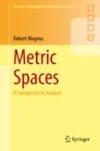- About MAA
- Membership
- MAA Publications
- Periodicals
- Blogs
- MAA Book Series
- MAA Press (an imprint of the AMS)
- MAA Notes
- MAA Reviews
- Mathematical Communication
- Information for Libraries
- Author Resources
- Advertise with MAA
- Meetings
- Competitions
- Programs
- Communities
- MAA Sections
- SIGMAA
- MAA Connect
- Students
- MAA Awards
- Awards Booklets
- Writing Awards
- Teaching Awards
- Service Awards
- Research Awards
- Lecture Awards
- Putnam Competition Individual and Team Winners
- D. E. Shaw Group AMC 8 Awards & Certificates
- Maryam Mirzakhani AMC 10 A Awards & Certificates
- Two Sigma AMC 10 B Awards & Certificates
- Jane Street AMC 12 A Awards & Certificates
- Akamai AMC 12 B Awards & Certificates
- High School Teachers
- News
You are here
Metric Spaces: A Companion to Analysis

Publisher:
Springer
Publication Date:
2022
Number of Pages:
264
Format:
Paperback
Series:
Springer Undergraduate Mathematics Series
Price:
44.99
ISBN:
978-3-030-94945-7
Category:
Textbook
The Basic Library List Committee recommends this book for acquisition by undergraduate mathematics libraries.
[Reviewed by , on ]
John Ross
02/19/2023
Metric Spaces: A Companion to Analysis is a self-contained text that covers the basic metric space theory necessary in studying various branches of analysis. In this text, Robert Magnus offers an excellent primer and reference for major concepts related to metric spaces, as they would be useful for a graduate student in mathematics.
The prerequisites for this text are a solid understanding of “fundamental analysis” (what the author calls material related to the study of analysis of one real variable). This has the potential to position this text in an awkward position within a standard (U.S.-based) curriculum, at the upper edge of the undergraduate curriculum but perhaps a bit below that of a first-year graduate student. I would enthusiastically recommend this book for a student who has already taken a basic real analysis course and is interested in pursuing a graduate degree in any analysis-adjacent field. As a result, this text would make an excellent main text for an advanced independent study, or an approachable and friendly companion text for a first-year graduate student.
The text is divided into seven chapters. The first chapter familiarizes the reader with metric spaces; defining them and identifying some important examples (including the usual sequence spaces and function spaces of functional analysis). In Chapter 2, the text identifies many basic tools of metric space theory, including open and closed sets, continuous mappings, topologies, and homeomorphisms. Starting in Chapter 3, then, the text devotes a chapter each to the properties of Completeness, Compactness, Separability, and Connectedness (Chapters 3,4,5, and 7), with Chapter 6 circling back to discuss advanced properties of complete spaces. Each chapter (really, each section) has numerous exercises to aid in the reader’s study.
In addition to the standard sections each chapter is comprised of, most chapters end with one or more advanced “excursion” sections. These excursions contain material that is not central to the study of metric space theory, but instead are major results that are used in the advanced study of analysis. A few examples (there are many more) include sections on the Mazur-Ulam Theorem, Tietze’s Theorem, the notion of Invertible Operators, and the Stone-Weierstrass Theorem. In setting up these excursion sections, I think Magnus does a real service: the reader of this text will be able to pick and choose the excursions that most closely align with their future studies.
Having spent some time with this book, I think it is a real winner. It is very approachable and well-paced; it’s precise but never too dry; its exercises are well thought out; and through its excursions and exposition, it gives the reader a solid foundation in metric space theory, with an understanding of where this theory sits within the broader fields of topology and analysis.
John Ross is an assistant professor of mathematics at Southwestern University.
See the publisher's website.
- Log in to post comments




